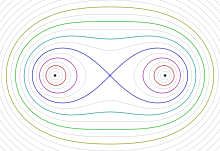Cassini oval

A Cassini oval is a quartic plane curve defined as the set (or locus) of points in the plane such that the product of the distances to two fixed points is constant. This may be contrasted to an ellipse, for which the sum of the distances is constant, rather than the product. Cassini ovals are the special case of polynomial lemniscates when the polynomial used has degree 2.
Cassini ovals are named after the astronomer Giovanni Domenico Cassini who studied them in 1680.[1] Cassini believed that the Sun traveled around the Earth on one of these ovals, with the Earth at one focus of the oval. Other names include Cassinian ovals, Cassinian curves and ovals of Cassini.
Formal definition
Let q1 and q2 be two fixed points in the plane and let b be a constant. Then a Cassini oval with foci q1 and q2 is defined to be the locus of points p so that the product of the distance from p to q1 and the distance from p to q2 is b2. That is, if we define the function dist(x,y) to be the distance from a point x to a point y, then all points p on a Cassini oval satisfy the equation
Equations
If the foci are (a, 0) and (−a, 0), then the equation of the curve is
When expanded this becomes
The equivalent polar equation is
Shape
The curve depends, up to similarity, on e = b/a. When e < 1, the curve consists of two disconnected loops, each of which contains a focus. When e = 1, the curve is the lemniscate of Bernoulli having the shape of a sideways figure eight with a double point (specifically, a crunode) at the origin.[2][3] When e > 1, the curve is a single, connected loop enclosing both foci. It is peanut-shaped for and convex for .[4] The limiting case of a → 0 (hence e → ), in which case the foci coincide with each other, is a circle.
The curve always has x-intercepts at ±c where c2 = a2 + b2. When e < 1 there are two additional real x-intercepts and when e > 1 there are two real y-intercepts, all other x and y-intercepts being imaginary.[5]
The curve has double points at the circular points at infinity, in other words the curve is bicircular. These points are biflecnodes, meaning that the curve has two distinct tangents at these points and each branch of the curve has a point of inflection there. From this information and Plücker's formulas it is possible to deduce the Plücker numbers for the case e ≠ 1: degree = 4, class = 8, number of nodes = 2, number of cusps = 0, number of double tangents = 8, number of points of inflection = 12, genus = 1.[6]
The tangents at the circular points are given by x ± iy = ±a which have real points of intersection at (±a, 0). So the foci are, in fact, foci in the sense defined by Plücker.[7] The circular points are points of inflection so these are triple foci. When e ≠ 1 the curve has class eight, which implies that there should be at total of eight real foci. Six of these have been accounted for in the two triple foci and the remaining two are at
So the additional foci are on the x-axis when the curve has two loops and on the y-axis when the curve has a single loop.[8]
When the foci of the Cassini ovals are the points (a,0) and (-a,0), the equilateral hyperbolas centered at (0,0) and passing through the foci are curves orthogonal to the Cassini ovals.
Examples
The second lemniscate of the Mandelbrot set is a Cassini oval defined by the equation . Its foci are at the points c on the complex plane that have orbits where every second value of z is equal to zero, which are the values 0 and -1.
See also
References
- Bibliography
- J. Dennis Lawrence (1972). A catalog of special plane curves. Dover Publications. pp. 5,153–155. ISBN 0-486-60288-5.
- R. C. Yates (1952). A Handbook on Curves and Their Properties. Ann Arbor, MI: J. W. Edwards. pp. 8 ff.
- A. B. Basset (1901). An Elementary Treatise on Cubic and Quartic Curves. London: Deighton Bell and Co. pp. 162 ff.
- Lawden, D. F., "Families of ovals and their orthogonal trajectories", Mathematical Gazette 83, November 1999, 410–420.
External links
| Wikimedia Commons has media related to Cassini oval. |
- Hazewinkel, Michiel, ed. (2001), "Cassini oval", Encyclopedia of Mathematics, Springer, ISBN 978-1-55608-010-4
- MacTutor description
- Weisstein, Eric W. "Cassini Ovals". MathWorld.
- 2Dcurves.com description
- "Ovale de Cassini" at Encyclopédie des Formes Mathématiques Remarquables (in French)
- "MacTutor History of Mathematics" Famous Curves